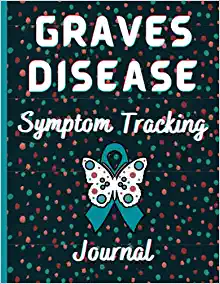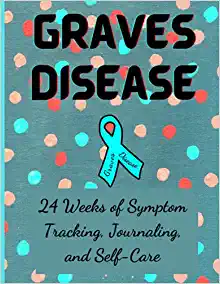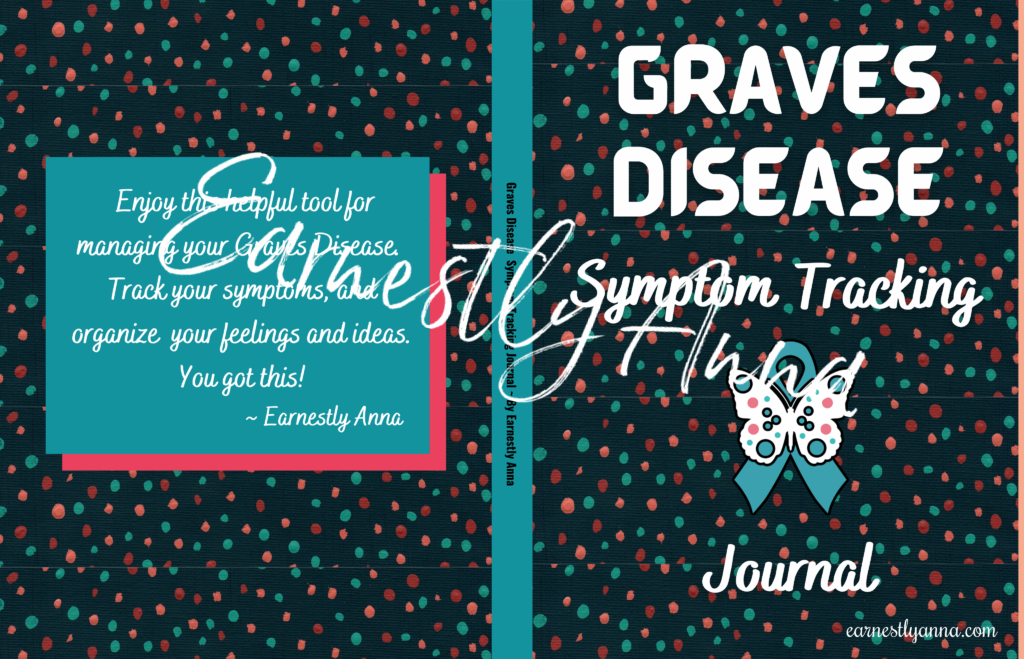Keeping a Graves Disease Journal
Last Updated on September 30, 2023 by Anna Baumann
Keeping a Graves Disease Journal
I’m sorry that I didn’t start keeping a Graves Disease journal a long time ago. I’ll tell you how my little project came about. But first, I want to tell you;
Why you need a Graves Disease Symptom Tracking Journal
Identify your triggers.
Using a tracking chart forces you to examine your physical symptoms. In 2015, the Endocrinologist I was finally referred to diagnosed my Graves. By the time I saw her, I dealt with a slew of symptoms for over a year. I was exhausted, and I forgot to tell her about things that started months before because new ones kept popping up. My body felt like a towel in the dryer and I was too overwhelmed to know what triggered what. When you track, you see patterns develop for what you were doing or not doing when you felt a certain way. Once you know what’s triggering your symptoms, you can work on ways to treat them.
Track your treatments.
Graves is inconsistent and unpredictable. We all have different symptoms and, what works for someone else might not work for us at all. That is one of the many frustrating things about it! There’s an endless amount of natural and medical treatments that are very helpful for many patients. Tracking forces us to reflect on how we feel so we know what does and doesn’t work for us. It’s also the perfect way to remember what we have and haven’t tried.
Preserve your memories.
Have you heard about brain fog? Several years post thyroid removal and I still get the fog. In fact once you start your journal and read back a few weeks, you’ll realize how much you already forgot! Good things happen and people say things that we want to hold on to. Even if it’s just so that we can mull it over later. But we can’t mull over what we don’t remember. Record your joyful moments. Writing is a beautiful way to express yourself, and it’s important to have a private place to relive happy memories.
Have a safe place to vent.
Purge your Graves Rage! Sometimes we have strong feelings about something, and we’re not sure why. I know that happens to me a lot. Whether it’s something that happened or something someone said, I often have to stop and ask myself, “Why am I so upset about this?” Unfortunately, you won’t always come up with an acceptable answer 🙂 . But, you will feel calmer when you organize your thoughts and vent your feelings.
Why I created a Graves Disease Symptom Tracking Journal
I was looking for an emotional outlet, so I started an informal kind of journal for myself. I was feeling overwhelmed at home one day and just opened up a Word document and started typing. The next time the spirit moved me to write my feelings down, I was at work. So I grabbed some printer paper before lunch, went out to my car, and just wrote… That’s when I decided I needed a dependable place for purging and organizing my thoughts.
When I got online to buy a journal, of one of those pain symptom trackers popped up in the search. That got me thinking about a Graves symptom tracker that I’d been wanting to make. Just one of those things I’ve thought about creating to use myself, and share here on the blog. It was a lightning-bolt moment and I thought, why not create a combination journal and symptom tracker?! I was thrilled with the idea and the thought of working on a new project!
The part I was most excited about was the cover. Instead of ordering the journal that day, I got some canvas paper and paintbrushes. I already had a nice assortment of acrylic paints, so I was all set to get artsy. Once I got started I remembered something about myself; I have no artistic ability. I can decorate a cake with frosting or fondant and even crochet a little. But put a pencil or paintbrush in my hand and I’m useless. Which is a shame really because I have such enthusiasm and I love all the colors.
Another little-known fact about me is that I love polka-dots. For my journal cover, I envisioned a whimsical combination of butterfly and awareness ribbon surrounded by polka-dots. My result was less whimsical and more childlike. And when I say childlike I mean it looked like it was done by a 6-year-old. (No offense to six-year-olds.)
After a lot of re-positioning, cropping, adding, and subtracting, the photo above became the cover below. Still no Picasso, but living proof that sometimes all you need is a smidge of inspiration.
Once I finished the cover, I set the book up with a symptom tracking chart, and additional pages for recording treatments, goals, events, thoughts, and feelings.
Tips for using a Graves Disease Symptom Tracking Journal
-
- Read the instructions. It’s tempting to just jump in and start writing. But unless it’s just a book of lined pages, most symptom trackers and journals will start with a short introduction and instruction blurb. Take the time to read them. You can tweak it to your own taste, and do your own routine. But knowing what the creator’s thought process was, will help you get the most benefit from it.
- Keep it in a special place. A paperback format means it’s easy to travel with. Keeping it at your bedside is a nice idea because you can add to it at the end of the day. Your home office desk is also a great idea. I like to keep mine in my car. That way I have it with me if the weather is nice, and I can get outside on my lunch break. Decide where you’ll be likely to use it most, and keep it there.
- Use a special pen. If you’ve been saving a favorite pen to use for a special occasion, this is it! If you don’t have a special one, it’s time to treat yourself. Think about the size, shape, weight, color, and ink. Then get one that you love, and keep it with your journal. Using that pen will be another something to look forward to during your writing time.
- Be brutally honest. You’re doing this to help you. Don’t worry about how things ‘sound’ or about spelling and punctuation. This is your place to purge your heart and mind and organize your private thoughts. Be your true self, and be true to yourself when you write!
- Bring it to your doctor’s appointments. A big benefit of the symptom tracker is that it helps you remember. Your doctor doesn’t need to read anything, but you can still bring it with you and refer to it as you share information.
- Don’t force it. Sometimes people avoid journaling because they view it as too big of a commitment. It’s a helpful tool. But it should be something you look forward to and want to do. So just go ahead and make it what you want it to be! I chose a weekly format. If that seems too much for you try every two weeks or once a month. New habits are hard to start, so ease your way in. No pressure!
So there you have it! That’s my keeping a Graves Disease journal story. Links to the journals are below. If you’d like a trial run at symptom tracking, grab a free printable chart and give it a go! If you decide to get a journal, I sincerely hope it helps you to find and treat your triggers!












Thank you for this. I was just diagnosed today. I am glad to finally have a diagnosis but also scared about the ‘nodules’ and lifetime battle.
I understand, it is scary. But again, at least now you know what it is and are being treated for it. You can also be your own advocate. Track your symptom and find what does and doesn’t work for you. I hope you get back to feeling some sense of peace and good health very soon!
I was told my Graves is in remission but I’m still having symptoms. Is this normals? My doctors basically don’t know or say that’s strange. The serious symptoms are gone like A-fib and shaking but my severe anxiety and hair loss etc remains an issue. Any advice or resources would be great as I feel lost and tired of feeling sick and I want to feel better.
Hi Diana! I think one of the biggest frustrations with Graves is that nothing works the same for everyone. In my experience, it is normal to feel unwell even when thyroid hormone levels are in a normal range. Our bodies attack themselves, so who knows what’s going on in there? If you can pinpoint things that trigger your symptoms, you can at least learn what to avoid. And I always say, be willing to try anything because you never know what might end up working for you. (Check with your doctor before making any big changes though.) The best resources I’ve found are other people who have Graves. I don’t love Facebook but Graves Disease groups were a big help to me when I was first diagnosed. They’re just a great place to ask questions and scroll through for ideas. Also, you can always stop by here 🙂 or send me an email at anna@earnestlyanna.com.
Thank you. I was diagnosed a few years ago with hyperthyroidism and graves disease. They treated the thyroid with radioactive iodine. My endocrinologist told me I have graves disease and that there’s no cure, I’ll have it for the rest of my life. No info. No plan of action. Nothing. I’ve search on here for information but basically all I find is info on hypothyroidism and hashimato disease, until today. Now I’m flooded with graves articles. Yours have been very helpful
Hi Donna! I’m so happy that you’ve found some help here! That’s why I share my Graves experiences, so fellow Gravesters know they’re not alone. If you ever have anything specific you need to chat about, feel free to email me at anna@earnestlyanna.com. Also, if you’re on Facebook there are a lot of Graves Disease-related groups you can join. I have a small group there where I share my blog posts. It’s growing slowly but we’d love to have you. It’s called Graves Disease Warriors. Groups are a nice way to get helpful ideas and ask questions. Thank you so much for visiting!